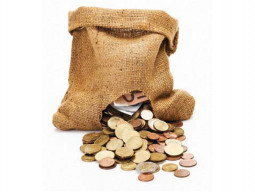
The federal government has failed to deliver on two most critical economic indicators, as it could not achieve the targets of increasing investment and savings during the outgoing fiscal year, highlighting that key economic problems still persist in the country.
Against the target of increasing investment to 15.1% of total national output, the investment remained at 14% in fiscal year 2013-14, said sources in the Economic Advisory wing of the Ministry of Finance. Savings-to-gross domestic product (GDP) ratio also dropped below the 14% target.
Per capita income, however, marginally rose 1.9% to $1,380. In the last fiscal year, per capita income was $1,354, sources said.
The inability to achieve investment and savings targets will deal a blow to government’s efforts to revive the economy, as it has already missed the key economic growth target. Against the target of 4.4%, the economy expanded 4.1%.
The investment-to-GDP ratio that the PML-N government achieved in its first year stood even below the 14.2% level, which was recorded in the last year of the Pakistan Peoples Party government.
This failure is contrary to the perception created by Finance Minister Ishaq Dar, who has been repeatedly stating that foreign investors are keen to invest in Pakistan.
The 15.1% figure was conservative as at the time of setting the target Dar wanted to fix the ratio at 15.5%, sources added.
Fixed investment remained at 12.4% of GDP, below last year’s 12.5%. On the contrary, the government had planned to increase the fixed investment level to 13.5%.
One reason behind the missed investment target was the government’s decision to drastically reduce expenditures under the Public Sector Development Programme, sources said.
According to a recent study conducted by the World Bank, Pakistan is in dire need of building infrastructure and needs to invest at least 6.6% and at most 9.5% of national output in meeting deficiencies in critical areas. It has worked out Rs2.5 trillion per year investment in infrastructure.
The study concluded that the drawbacks of ignoring investment in transport, electricity, water supply and sanitation, solid waste, telecom and irrigation were that the country’s economic growth would be slow, poverty would inch up and development goals would never be achieved.
But against the development budget of Rs540 billion, the government is going to end the year with spending of around Rs350 billion.
The target of savings-to-GDP ratio also could not be met. Compared to the target of 14%, savings grew only 13% in the outgoing fiscal year, said sources in the Ministry of Finance.
Again, the achieved ratio of 13% was even worse than the last year of the PPP government when savings were 13.3% of GDP. The low savings rate increases a country’s dependency on foreign borrowings for development and running the state’s affairs, according to economists.
In terms of governance and economic performance, the PPP’s last year is considered the worst among five years of its rule.
Targets for 2014-15
For the next fiscal year, the government is likely to set the investment-to-GDP target at 15.5%, sources said. The savings-to-GDP target may be set at 14.1%.
For the upcoming year, the government may project the current account deficit – gap between foreign receipts and payments – at 1.4% of GDP. For the outgoing year, the current account gap is likely to be 1% of GDP.
Published in The Express Tribune, May 22nd, 2014.
Like Business on Facebook, follow @TribuneBiz on Twitter to stay informed and join in the conversation.
COMMENTS (5)
Comments are moderated and generally will be posted if they are on-topic and not abusive.
For more information, please see our Comments FAQ























1714034954-0/WhatsApp-Image-2024-04-25-at-1-48-04-PM-(1)1714034954-0-270x192.webp)




















So everything being claimed by ID during his jugular type PCs were just a joke to nation...cursed people cursed government cursed leaders
Pmln government is only good at creating hypes of being business friendly. This report proves they are worse than even the PPP government.
@Zain: New money created by the SBP is lent to the government. It is not given away. Regardless, it is highly inflationary and you are effectively robbing from your own people.
Imran Khan cannot bring back money held in Swiss banks because the Swiss are not going to let him. Wherever did you get the idea that IK has leverage over Swiss banks? Just one of those banks has a market cap larger than this country's entire GDP.
If you do debt financed investment, then people complain about high budget deficit and rising domestic debt. If you lower deficit and impose austerity, people complain about lower government spending.
I believe Imran would have brought Economy 2.0 thinking. High budget deficit would not have occurred even with high government spending as he would order the SBP to make money and the $500 billion in Swiss banks would be brought back.
Total fail by pmln govt.